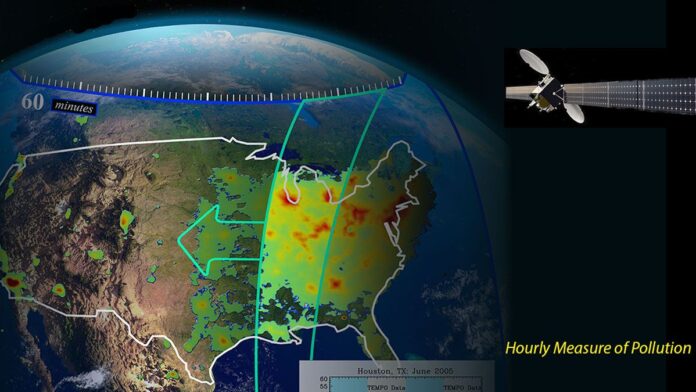Satellites have been used to measure air pollution from space for years. For the first time, a space-borne smog sensor will be able to provide data on distribution of air pollutants over America non-stop and in real time.
The new sensor, called Tropospheric Emissions: Monitoring of Pollution, or TEMPO, will be the first instrument of its kind that will measure concentrations of dangerous air pollutants from geostationary orbit, the ring 22,000 miles (36,000 kilometers) above the equator where satellites remain over a fixed spot on Earth.
From this vantage point, TEMPO will be able to detect hourly changes in the concentrations of nitrogen oxide, ozone and formaldehyde above the entire U.S., allowing scientists the first opportunity to monitor not only how air pollution levels vary during the day, but also where air pollutants flow as a result of atmospheric processes.
Related: Satellites discover huge amounts of undeclared methane emissions
All previous space-borne air pollution sensors have been mounted on satellites in low Earth orbit, orbiting our planet at an altitude of 600 miles (1000 km) or less. But these satellites, although they circle Earth up to 15 times a day, only get a view of the same region about once a day, which is not enough to understand how air pollution concentrations change within a single day.
“These orbiters go over a particular place on Earth, usually at the same time of day,” Caroline Nowlan, an atmospheric physicist at the Center for Astrophysics at Harvard & Smithsonian and TEMPO science team member, said during a NASA news conference on Tuesday (March 14). “So every day, we can get measurements, say, over New York City at 1:30 in the afternoon. But that’s just one data point over New York over a day, and a lot is happening in New York City over a day. We have two rush hours that we’re not able to capture. And so the great thing about TEMPO is that for the first time, we’ll be able to make hourly measurements over North America. So we’ll be able to see what’s happening over a whole day as long as the sun is up.”
TEMPO is scheduled to launch to space on one of SpaceX‘s Falcon 9 rockets on April 7, 2023 and will be mounted on the telecommunication satellite Intelsat 40e operated by the American company Intelsat. So far, TEMPO has funding secured for 20 months, but scientists hope the instrument will remain operational over the entire 15-year lifespan of its host spacecraft.
TEMPO is a spectrometer that will scan Earth’s atmosphere above the U.S. from the East Coast to the West Coast and measure how chemicals in the air absorb visible and ultraviolet light. From those measurements, scientists will be able to deduce how much nitrogen dioxide, formaldehyde and ozone is dispersed in the air.
“Nitrogen dioxide is a byproduct of combustion,” Barry Lefer, the tropospheric composition program manager at NASA, said in the same news conference. “So when we’re burning gasoline, or diesel fuel to move ourselves around, or electric generation plants burning coal or natural gas, a byproduct of that activity is nitrogen dioxide, and it’s harmful to human health. It’s a primary pollutant and in the atmosphere, it reacts to make ozone and formaldehyde, the secondary pollutants which are also harmful to human health.”
Despite sitting 22,000 miles above Earth, TEMPO will be able to discern concentrations of those pollutants with the same resolution as the best existing sensors on satellites in low-Earth orbit. This will enable the researchers to see how air pollution concentrations vary from neighborhood to neighborhood within a day, how long the pollutants last in the air and how they spread across major urban centers.
The team plans to run first air quality studies using the instrument this summer, focusing on L.A., Chicago and New York, Lefer said in the news conference.
The U.S. National Oceanic and Atmospheric Administration and the Environmental Protection Agency will have access to the data from early on to improve their air pollution forecasts and environmental protection policies, respectively.
TEMPO was developed jointly by researchers at NASA and the Smithsonian Astrophysical Observatory in Cambridge, Massachusetts.
Follow Tereza Pultarova on Twitter @TerezaPultarova (opens in new tab). Follow us on Twitter @Spacedotcom (opens in new tab) and on Facebook (opens in new tab).

